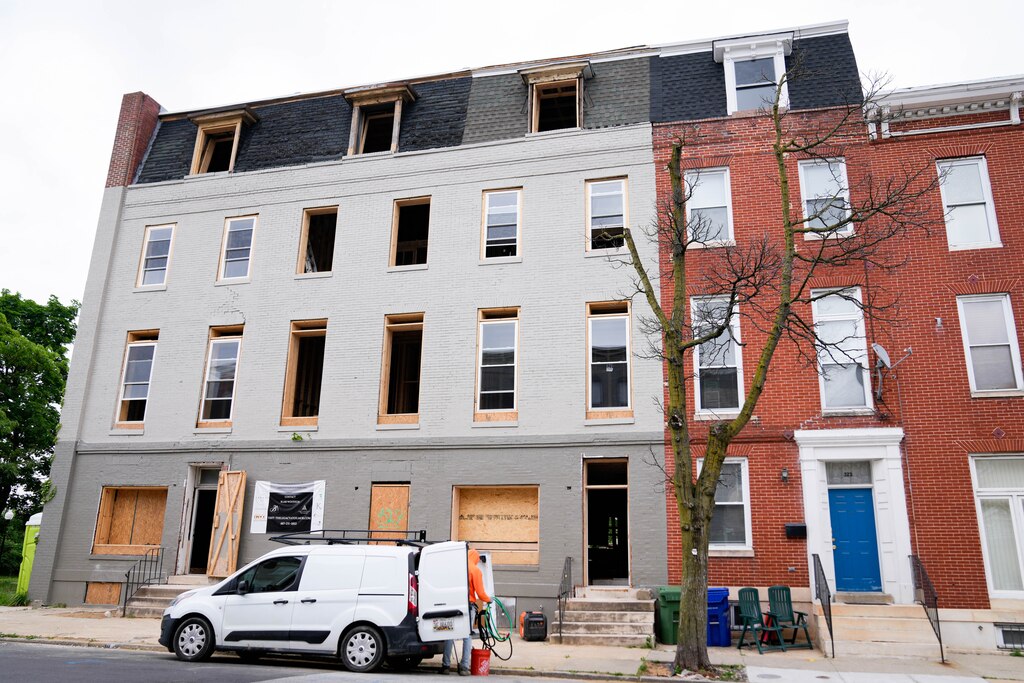Baltimore leaders introduced a package of bills Monday aimed at making homes easier to build and rehabilitate as the city undertakes an ambitious effort to turn the tide on its thousands of vacant homes.
The legislation, engineered by several members of the City Council and endorsed by Mayor Brandon Scott, would roll back restrictions on development density, allow people to build closer to their property lines, and do away with requirements for off-street parking if approved.
Unveiled at a joint news conference in the City Hall rotunda, Councilman Ryan Dorsey, the driving force behind the legislation, said the bills would help the city grow its population and reverse some of the damage from decades of overly constrictive — and racist — housing policies.
“Nothing stands more clearly in our way than our own laws of prohibition and division,” Dorsey, a third-term Northeast Baltimore Democrat, said. “The bills being introduced today are the first, modest step to correcting course.”
The Baltimore Banner thanks its sponsors. Become one.
The most sweeping bill proposed Monday would allow multifamily housing of two to four units in city residential districts that currently only allow single-family living. The number of units would be dependent on the square footage of available living space in a building — 1,500 square feet would limit a developer to two units, while 3,000 square feet could be divided into up to four.
A separate bill introduced by Dorsey would remove a requirement within city building code that structures over three stories must have two internal staircases and a passageway that connects them.
Eliminating both rules would allow for more units and make it easier for builders to finance rehabilitation projects, officials said.
“Baltimore is ready to build smarter, fairer and we’re cutting the red tape,” Scott said, “helping to bring our zoning and building code into the 21st Century and putting the needs of our residents first.”

Another bill, introduced by Councilman Zac Blanchard, would remove a requirement for off-street parking. Dorsey pointed to parking requirements for small vacant lots in the city’s dense Mount Vernon neighborhoods. Such requirements make development of the lots difficult, he said, and potentially more expensive. And the current requirements frequently aren’t enforced.
The Baltimore Banner thanks its sponsors. Become one.
The bills dovetail with a $3 billion initiative Scott rolled out with the Greater Baltimore Committee and BUILD Baltimore, an interfaith community advocacy group, in 2023. The proposal calls for remediating more than 35,000 properties over 15 years. The plan would borrow at least $300 million and the administration is seeking at least $750 million from the state and millions more from private investors.
Late last year, city officials got rolling with the creation of a unique tax district that will allow them to borrow money against future property tax growth. This so-called “non-contiguous” tax increment financing district, unlike ones established previously along the city’s waterfront, includes dilapidated properties across the city, most in East and West Baltimore.
Since then, officials have introduced more strategies for alleviating or removing the numerous impediments to development in the city. Reforms to the city’s notoriously slow permitting process have been announced, and city government officials have been meeting regularly with state and private sector partners to brainstorm ideas and solutions for financing the vacant housing initiative and addressing possible barriers.
Rian Hargrave, who joined city officials for Monday’s event, is among the developers who stand to benefit if the legislation is passed. Hargrave’s Onyx Development has been rehabilitating a group of homes in the 300 block of North Gilmor Street, just south of the city’s infamous Highway to Nowhere. The massive 3,000-square-foot properties could have comfortably been redeveloped into two units, but city zoning code barred it.
The “mini mansions” will instead become four-bedroom, three-bathroom single-family homes, Hargrave said, which are difficult for first-time homebuyers to afford.
The Baltimore Banner thanks its sponsors. Become one.
“It’s not about making this like New York with a ton of families in one single space,” Hargrave said of the proposed zoning changes. “It’s meeting our real estate where it’s at.”
Dorsey and Scott acknowledged there will likely be pushback to some of the legislation. Monday afternoon, City Councilman James Torrence, a Democrat representing West Baltimore, offered some early feedback, arguing the changes should not be implemented broadly, as proposed.
Torrence said there have been instances in his district where parking requirements have prevented development that neighbors oppose, specifically a drug rehabilitation facility. Other neighborhoods, such as Reservoir Hill, already have little parking to spare.
“I thank you guys for the intent, but I think the intent is not surgically and precisely addressed,” Torrence said during a meeting of the City Council.
Dorsey argued Baltimore couldn’t have been built under current zoning restrictions. The status quo, he said, isn’t rising to meet modern demands.
The Baltimore Banner thanks its sponsors. Become one.
The mayor also acknowledged the potential for blowback, and said the bill sponsors would be meeting with community members across the city to discuss what the proposed laws would and wouldn’t do. He referred to the proposals as “incremental” changes that should be embraced rather than feared.
“My job is to do the right thing,” he added, “even if it’s not popular.”



Comments
Welcome to The Banner's subscriber-only commenting community. Please review our community guidelines.